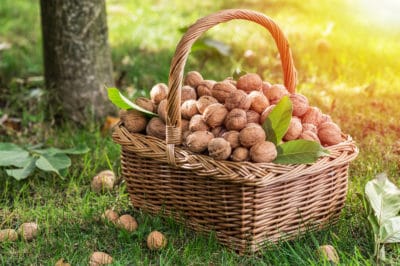Timing Your Harvest
English walnuts — the most commonly cultivated variety — grow in USDA plant hardiness zones 4 through 9. Depending on where you live in that range, expect harvest time to fall between late August and early October. When the walnuts are ready, they’ll begin dropping to the ground around your trees with their hulls cracked.
Expert gardener’s tip: To be certain you’re not jumping the harvesting gun, peel the hulls from some of the nuts and then crack open their inner shells. If they’re ripe, the hulls will slip off without resisting and the tissue separating the shells from the walnut kernels will be brown.
Things You’ll Need
To harvest English walnuts you need:
- Plastic or rubber gloves to keep the nuts from staining your hands
- A pole to shake the trees’ branches
- Protective headgear
- Tarps or blankets to catch falling walnuts
- Buckets, boxes or heavy-duty collection bags
- A high-pressure garden hose
- Outdoor tables for washing and drying the walnuts
- A nutcracker (optional)
- Airtight storage containers
Harvesting and Processing
English walnuts are much easier to harvest and process than their black walnut relatives. Wearing your gloves and headgear, gather the fallen walnuts. Then spread tarps or blankets beneath a tree and shake the branches gently with your long pole. Collect what lands on the tarps. The walnuts remaining on the tree aren’t ripe.
Hulling
Peel the hulls with your gloved hands and dispose of the walnuts with cracked inner shells. Spread the hulled ones on outdoor tables so they aren’t touching. Then rinse them thoroughly with your garden hose to remove hull remnants. While they dry, examine them and dispose of the ones with cracked shells.
Drying
Move the clean, hulled nuts to drying screens and set them somewhere warm to air dry. After two weeks, remove some of the kernels and break them in two. If they snap easily, they’re dry.
Storing
Always store your walnuts (shelled or unshelled) in airtight containers. Kept in a cool, dry place, shelled ones stay fresh for several months. Shelled nuts last up to six months when refrigerated and a year or more when frozen.
